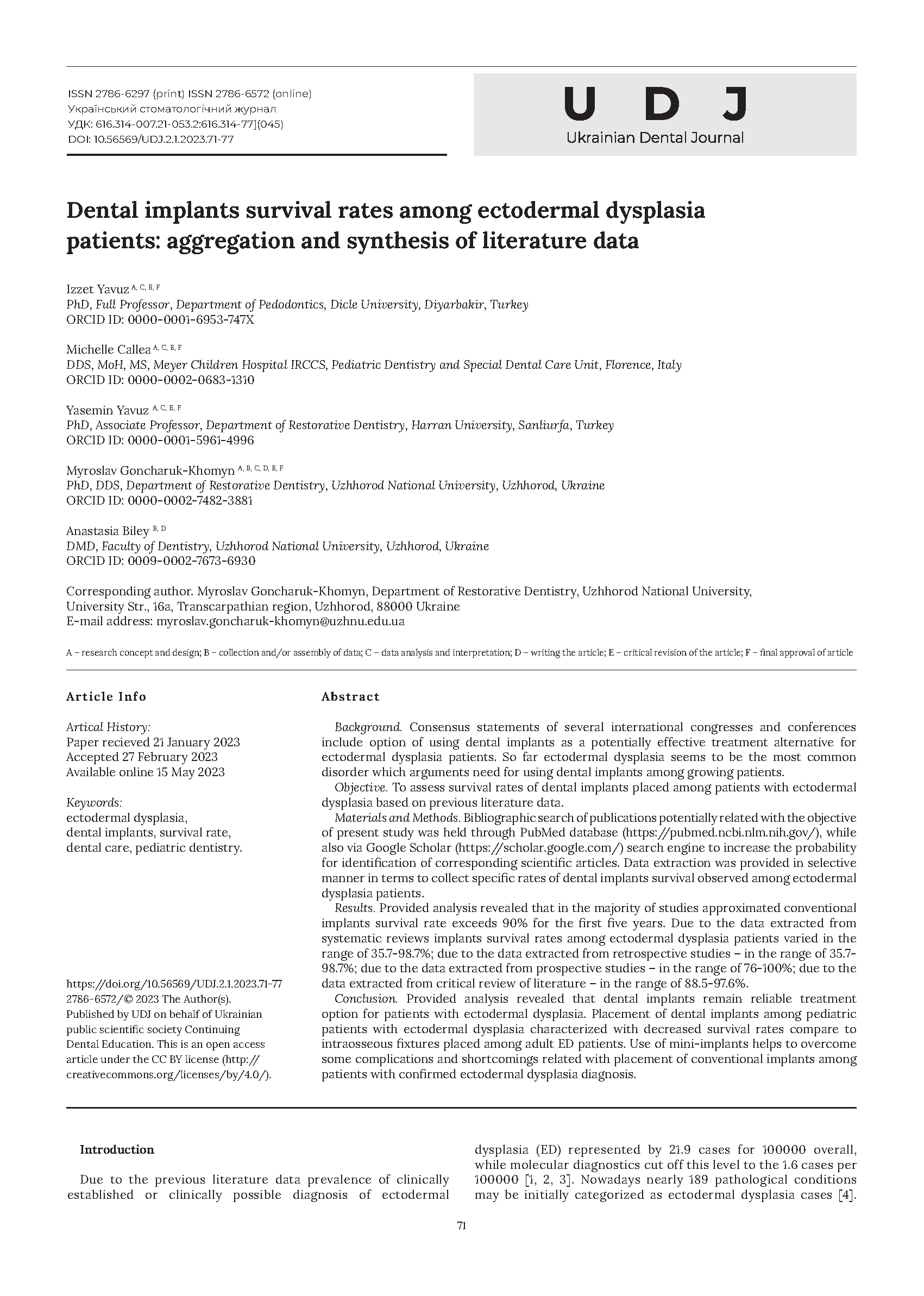Dental implants survival rates among ectodermal dysplasia patients: aggregation and synthesis of literature data
DOI:
https://doi.org/10.56569/UDJ.2.1.2023.71-77Keywords:
ectodermal dysplasia, dental implants, survival rate, dental care, pediatric dentistryAbstract
Background. Consensus statements of several international congresses and conferences include option of using dental implants as a potentially effective treatment alternative for ectodermal dysplasia patients. So far ectodermal dysplasia seems to be the most common disorder which arguments need for using dental implants among growing patients
Objective. To assess survival rates of dental implants placed among patients with ectodermal dysplasia based on previous literature data.
Materials and Methods. Bibliographic search of publications potentially related with the objective of present study was held through PubMed database (https://pubmed.ncbi.nlm.nih.gov/), while also via Google Scholar (https://scholar.google.com/) search engine to increase the probability for identification of corresponding scientific articles. Data extraction was provided in selective manner in terms to collect specific rates of dental implants survival observed among ectodermal dysplasia patients.
Results. Provided analysis revealed that in the majority of studies approximated conventional implants survival rate exceeds 90% for the first five years. Due to the data extracted from systematic reviews implants survival rates among ectodermal dysplasia patients varied in the range of 35.7-98.7%; due to the data extracted from retrospective studies – in the range of 35.7-98.7%; due to the data extracted from prospective studies – in the range of 76-100%; due to the data extracted from critical review of literature – in the range of 88.5-97.6%.
Conclusion. Provided analysis revealed that dental implants remain reliable treatment option for patients with ectodermal dysplasia. Placement of dental implants among pediatric patients with ectodermal dysplasia characterized with decreased survival rates compare to intraosseous fixtures placed among adult ED patients. Use of mini-implants helps to overcome some complications and shortcomings related with placement of conventional implants among patients with confirmed ectodermal dysplasia diagnosis.
References
Nguyen-Nielsen M, Skovbo S, Svaneby D, Pedersen L, Fryzek J. The prevalence of X-linked hypohidrotic ectodermal dysplasia (XLHED) in Denmark, 1995–2010. Eur J Med Genet. 2013;56(5):236-42. doi: https://doi.org/10.1016/j.ejmg.2013.01.012
Goncharuk-Khomyn M, Yavuz I, Cavalcanti AL, Boykiv A, Nahirny Y. Key aspects of dental diagnostics and treatment specifics in ectodermal dysplasia patients: Comprehensive literature review. J Stomat. 2020;73(6):342-50. doi: https://doi.org/10.5114/jos.2020.102053
Yavuz Y, Doğan MS, Goncharuk-Khomyn M. Ectodermal Dysplasia: A Review. Makara J Health Res. 2021;25(3):9. doi: https://doi.org/10.7454/msk.v25i3.1305
Gökdere S, Schneider H, Hehr U, Willen L, Schneider P, Maier-Wohlfart S. Functional and clinical analysis of five EDA variants associated with ectodermal dysplasia but with a hard-to-predict significance. Front Genet. 2022;13:934395. doi: https://doi.org/10.3389/fgene.2022.934395
Guckes AD, Roberts MW, McCarthy GR. Pattern of permanent teeth present in individuals with ectodermal dysplasia and severe hypodontia suggests treatment with dental implants. Pediatr Dent. 1998;20(4):278-80.
Bohner L, Hanisch M, Kleinheinz J, Jung S. Dental implants in growing patients: a systematic review. Br J Oral Maxillofac Surg. 2019;57(5):397-406. doi: https://doi.org/10.1016/j.bjoms.2019.04.011
Schnabl D, Grunert I, Schmuth M, Kapferer‐Seebacher I. Prosthetic rehabilitation of patients with hypohidrotic ectodermal dysplasia: A systematic review. J Oral Rehabil. 2018;45(7):555-70. doi: https://doi.org/10.1111/joor.12638
Paulus C, Martin P. Hypodontia due to ectodermal dysplasia: rehabilitation with very early dental implants. Rev Stomatol Chir Maxillofac Chir Orale. 2013;114(3):e5-8. doi: https://doi.org/10.1016/j.revsto.2013.03.008
Seremidi K, Markouli A, Agouropoulos A, Polychronakis N, Gizani S. Rehabilitation Considerations for Very Young Children with Severe Oligodontia due to Ectodermal Dysplasia: Report of Three Clinical Cases with a 2-Year Follow-Up. Case Rep Dent. 2022; 2022:9925475. doi: https://doi.org/10.1155/2022/9925475
Clarke L, Bowyer L, Noone J, Stevens C, Yates J, Ashley M. Britain's youngest implant patients?–A Case Series of implant treatment in children with ectodermal dysplasia. Oral Surg. 2020;13(3):245-51. doi: https://doi.org/10.1111/ors.12479
Elagib MF, Alqaysi MA, Almushayt MO, Nagate RR, Gokhale S, Chaturvedi S. Dental implants in growing patients: A systematic review and meta-analysis. Technol Health Care. 2022;Preprint:1-4. doi: https://doi.org/10.3233/THC-220581
Gusenbauer M, Haddaway NR. Which academic search systems are suitable for systematic reviews or meta‐analyses? Evaluating retrieval qualities of Google Scholar, PubMed, and 26 other resources. Res Synth Methods. 2020;11(2):181-217. doi: https://doi.org/10.1002/jrsm.1378
Shariff SZ, Bejaimal SA, Sontrop JM, Iansavichus AV, Haynes RB, Weir MA, Garg AX. Retrieving clinical evidence: a comparison of PubMed and Google Scholar for quick clinical searches. J Med Internet Res. 2013;15(8):e164. doi: https://doi.org/10.2196/jmir.2624
Umberto G, Maiorana C, Ghiglione V, Marzo G, Santoro F, Szabò G. Osseointegration and guided bone regeneration in ectodermal dysplasia patients. J Craniofac Surg. 2007;18(6):1296-304. doi: https://doi.org/10.1097/01.scs.0000246497.62065.5a
Wu Y, Wang XD, Wang F, Huang W, Zhang Z, Zhang Z, Kaigler D, Zou D. Restoration of oral function for adult edentulous patients with ectodermal dysplasia: a prospective preliminary clinical study. Clin Implant Dent Relat Res. 2015;17:e633-42. doi: https://doi.org/10.1111/cid.12296
Yap AK, Klineberg I. Dental implants in patients with ectodermal dysplasia and tooth agenesis: a critical review of the literature. Int J Prosthodont. 2009;22(3):268-76.
Sweeney IP, Ferguson JW, Heggie AA, Lucas JO. Treatment outcomes for adolescent ectodermal dysplasia patients treated with dental implants. Int J Paediatr Dent. 2005;15(4):241-8. doi: https://doi.org/10.1111/j.1365-263X.2005.00610.x
Grecchi F, Pagliani L, Mancini GE, Zollino I, Carinci F. Implant treatment in grafted and native bone in patients affected by ectodermal dysplasia. J Craniofac Surgery. 2010;21(6):1776-80. doi: https://doi.org/10.1097/SCS.0b013e3181f40378
Bergendal B, Ekman A, Nilsson P. Implant failure in young children with ectodermal dysplasia: a retrospective evaluation of use and outcome of dental implant treatment in children in Sweden. Int J Oral Maxillofac Implants. 2008;23(3):520-4.
Kearns G, Sharma A, Perrott D, Schmidt B, Kaban L, Vargervik K. Placement of endosseous implants in children and adolescents with hereditary ectodermal dysplasia. Oral Surg Oral Med Oral Pathol Oral Radiol Endod. 1999;88(1):5-10. doi: https://doi.org/10.1016/s1079-2104(99)70185-x
Zou D, Wu Y, Wang XD, Huang W, Zhang Z, Zhang Z. A retrospective 3-to 5-year study of the reconstruction of oral function using implant-supported prostheses in patients with hypohidrotic ectodermal dysplasia. J Oral Implantol. 2014;40(5):571-80. doi: https://doi.org/10.1563/AAID-JOI-D-12-00162
Filius MA, Cune MS, Raghoebar GM, Vissink A, Visser A. Prosthetic treatment outcome in patients with severe hypodontia: a systematic review. J Oral Rehabil. 2016;43(5):373-87. doi: https://doi.org/10.1111/joor.12384
Wang Y, He J, Decker AM, Hu JC, Zou D. Clinical outcomes of implant therapy in ectodermal dysplasia patients: a systematic review. Int J Oral Maxillofac Surg. 2016;45(8):1035-43. doi: https://doi.org/10.1016/j.ijom.2016.03.011
Chrcanovic BR. Dental implants in patients with ectodermal dysplasia: A systematic review. J Craniomaxillofac Surg. 2018;46(8):1211-7. doi: https://doi.org/10.1016/j.jcms.2018.05.038
Peñarrocha-Diago M, Uribe-Origone R, Rambla-Ferrer J, Guarinos-Carbó J. Fixed rehabilitation of a patient with hypohidrotic ectodermal dysplasia using zygomatic implants. Oral Surg Oral Med Oral Pathol Oral Radiol Endod. 2004;98(2):161-5. doi: https://doi.org/10.1016/j.tripleo.2003.12.043
Goker F, Grecchi E, Mancini EG, Del Fabbro M, Grecchi F. Zygomatic implant survival in 9 ectodermal dysplasia patients with 3.5‐to 7‐year follow‐up. Oral Dis. 2020;26(8):1803-1809. doi: https://doi.org/10.1111/odi.13505
Sfeir E, Nassif N, Moukarzel C. Use of mini dental implants in ectodermal dysplasia children: follow-up of three cases. Eur J Paediatr Dent. 2014;15(2 Suppl):207-12.
Mello BZ, Silva TC, Rios D, Machado MA, Valarelli FP, Oliveira TM. Mini-implants: alternative for oral rehabilitation of a child with ectodermal dysplasia. Braz Dent J. 2015;26(1):75-8. doi: https://doi.org/10.1590/0103-6440201300111









